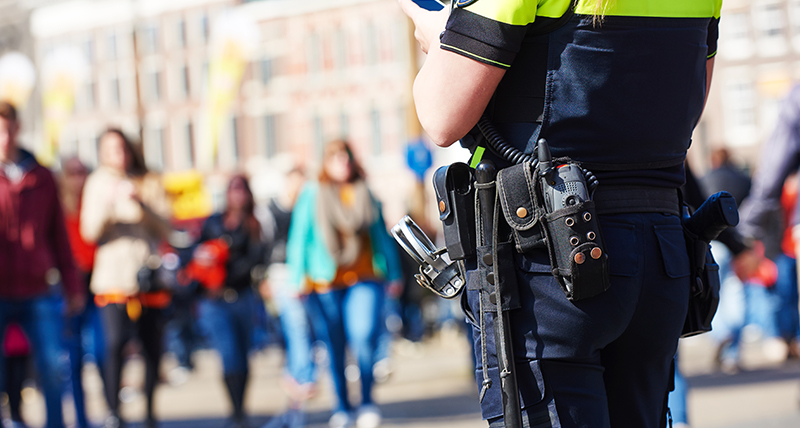How Johnson's County is recreating crime scenes with laser scanning
Q&A

Author: Renata Barradas Gutiérrez
If a picture says thousand words, imagine how 3D laser scanning augments perception to find truth in a crime scene investigation. Johnson's County Sheriff Office in Kansas, USA, has been using Leica Geosystems laser scanning technology for eight years. Reporter caught up with Andrea Reed from Johnson's County Sheriff Office criminalistics laboratory during HxGN LIVE 2018 to learn how laser scanning solutions from Leica Geosystems is bringing people back to any crime scene.
Capturing trusting evidence is critical. Could you please explain how laser scanning is used by Johnson's County to document and reconstruct scenes for public safety?
Laser scanning allows us to recreate crime scenes, so people step back into the crime scene in a digital reality. We use the Leica ScanStation to determine the spatial relationships, because crime scene photographs don't allow us to really show the spatial relationship between items and evidence.
In our agency, in Johnson County, Kansas, USA, we use laser scanning to document major crime scenes – whether it's a homicide, a suspicious death, officer-involved shootings, or any shooting scenes where we can do some reconstruction or use the ballistics rods.
Our crime scene investigators are proficient in using Leica ScanStations and Leica Cyclone 3D point cloud post-processing office software. We can create different outputs, such as snapshots in Cyclone software and show different types of pictures from the scanned data. We can also create TruView links, which allow people to step into the crime scene in a virtual way.
How does Leica Geosystems 3D laser scanners and software provide a forensic tool over traditional methods of crime scene mapping?

Laser scanning takes out the human factor of any type of error. 3D laser scanning goes above and beyond tape measures, protractors, and laser measuring devices and it's much more accurate and more precise than traditional methods of taking measurements by hand. And then when you go into what we can do with the data it far exceeds any other methods.
I always tell people, “You only have one time, one chance, to document and collect and preserve evidence at a crime scene. So why in the world would you not want to do it to the highest level of accuracy that you can?” And what better way than with a Leica Geosystems 3D laser scanner?
How is Leica Geosystems software supporting your needs?
Traditional methods only permit us to create 2D diagrams. With Cyclone you can create 3D models with different perspectives and floor plan layouts. With TruView Local people can actually step into a crime scene. TruView allow us to share point cloud data with an internet link to see a virtual and photo-realistic view of the sites. There was a case where we used a fly-through that showed the defendant had the opportunity to exit through a doorway but instead continued ahead to commit a homicide. We were able to show through scan data the path this person took, passing by an exit.During the conference I've heard about the Leica Geosystems Incident Mapping Software, Leica Map360, which I think would be extremely advantageous to us back at our laboratory and in our crime scene unit. I'm really excited to go back, and talk to my boss, and explain “this is what I think we should be using, here are the advantages to it, and this is how we can use it”, and just really step up our game.
What were the features in Map360 that caught your attention?
Map360 seemed like an easier workflow for shooting incident reconstruction and I really liked how you could diagram out scenes by using the point clouds you collected and captured. The desktop software allows users to create court ready documents and make an even more visual representation of a crime scene.
Could you provide an example on how data captured with laser scanning helped Johnson's County Sheriff Office to solve a case?

There is one case where we used the scan data beyond a floor plan and a layout of the scene. The District Attorney for the case said that the shooting reconstruction was key to the entire case. The defendant was stating they had acted in self-defence, however, using Cyclone we were able to show the different perspectives and use the trajectory cones, providing a more in depth look at the crime scene. It allowed the jury to see where the person was standing based on what we were able to show through Cyclone, ultimately discrediting the self-defence claim.
The output of the software helps us to do court exhibits. We often have floor plan layouts in large-size poster boards to explain during our testimony about what kind of evidence was found and where. We can show on our 3D laser scanner output layout where everything was within the crime scene. This really helps to orientate the jury as to what we are talking about and where in the crime scene we are talking about.
What have you learned at HxGN LIVE that will improve your work?

I took a session on Leica Cyclone REGISTER 360. We didn't realise that we had it at our disposal and now that I know that we have REGISTER 360 as part of our licensing, we can provide a more useful workflow and additional output.
What is the major take away for you at HxGN LIVE 2018?
Knowing the technology is there and it is going to keep changing, making things better and improving our workflow.
Reporter subscription
Contact Leica Geosystems
Want to learn more? We're here to answer your questions.
Want to learn more? We're here to answer your questions.

























